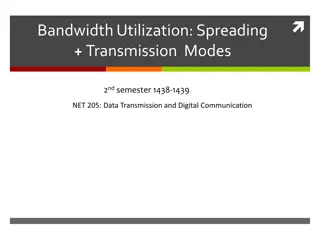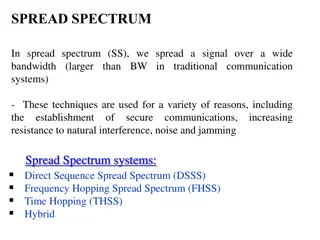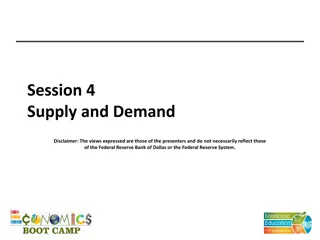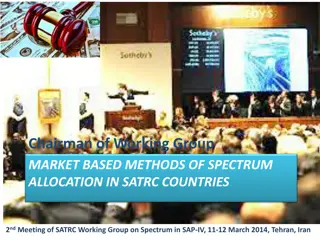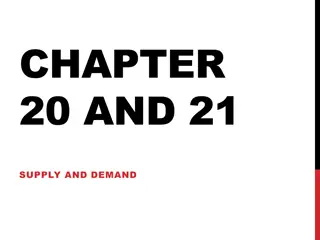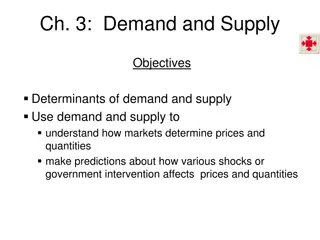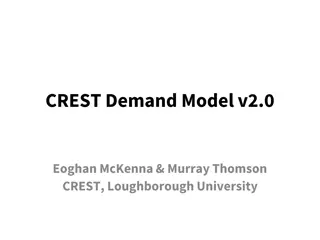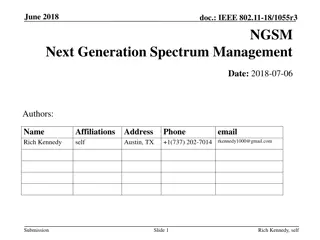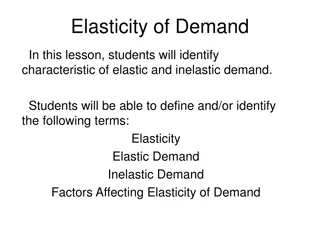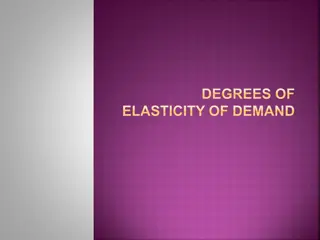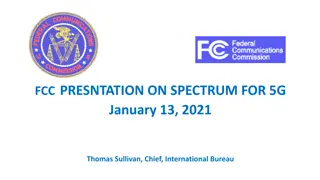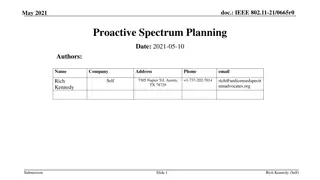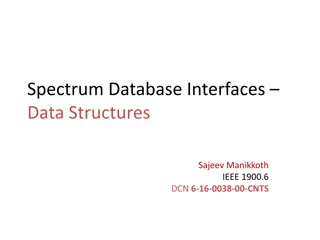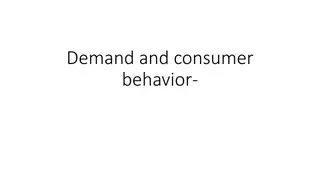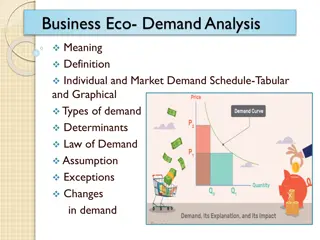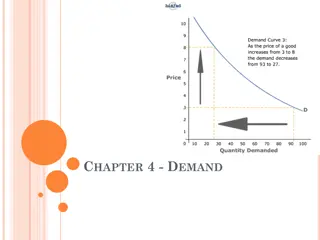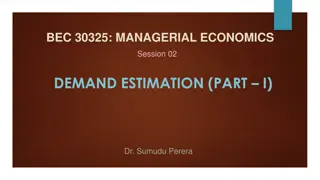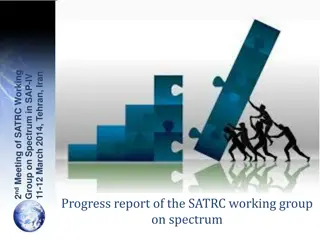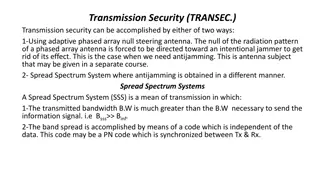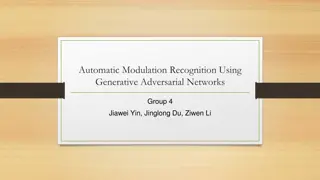Demand Estimation and Demand Forecasting
Demand estimation and forecasting are crucial processes for businesses to predict future demand for their products or services. Demand estimation involves analyzing the impact of various variables on demand levels and pricing strategies, while demand forecasting helps in planning production, new pro
2 views • 7 slides
INVENTORY MANAGEMENT.
Managing inventory under ISO 15189 guidelines involves Quantity, Quality, and Process management. Key aspects include demand forecasting, inventory movement control, consumption planning, and ensuring fitness for purpose. Quantity management aims to balance demand and supply, manage supply economics
6 views • 13 slides
Principles of Traffic Demand Analysis and Highway Demand Forecasting
Understanding traffic flows is crucial in designing highways and managing traffic effectively. Traffic demand analysis involves forecasting future traffic volumes, modeling demand, and determining the necessary infrastructure improvements. This analysis helps in estimating axle loadings, pavement th
2 views • 36 slides
Demand in Economics: Chapter 4 Overview
Demand in economics is dictated by the law of demand, where lower prices lead to increased purchases and vice versa. This chapter delves into the factors influencing demand, such as substitution effects, income effects, demand schedules, and market demand. Learn how shifts in the demand curve impact
1 views • 26 slides
The Law of Demand in Economics
The Law of Demand, explained by Dr. Pooja Singh, Assistant Professor at Chhatrapati Shahu Ji Maharaj University, Kanpur, outlines the inverse relationship between the price of a commodity and the quantity demanded. This fundamental economic principle states that as the price of a product decreases,
1 views • 9 slides
Spectrum Sensing for Enhanced Channel Access in Wireless Networks
This document presents a proposal for Spectrum Sensing Based Deferral (SSBD) to improve channel access in wireless networks. SSBD incorporates spectrum sensing with transmission deferral in a time-bound manner to enhance performance, reliability, and latency control. The proposed solution safeguards
4 views • 11 slides
Spread Spectrum Techniques in Data Transmission
Explore the concepts of bandwidth utilization, spreading, and transmission modes in data transmission and digital communication. Learn about spread spectrum techniques such as frequency hopping and direct sequence spread spectrum, which enable efficient sharing of wireless communication channels. Di
4 views • 28 slides
Spread Spectrum Communication Systems
Spread spectrum techniques involve spreading a signal over a wide bandwidth for various reasons, such as secure communication, resistance to interference, noise, and jamming. This summary introduces Direct Sequence Spread Spectrum (DSSS), Frequency Hopping Spread Spectrum (FHSS), Time Hopping, and h
1 views • 25 slides
The Hidden Benefit of Cool Roofs in Reducing Peak Energy Demand
Commercial building owners can reduce peak energy demand by installing cool roofs, leading to lower electricity costs and environmental benefits. Peak energy demand can strain the power grid, require additional capacity, and result in higher electricity rates. By understanding base use and peak dema
1 views • 31 slides
ICAO Handbook on Radio Frequency Spectrum Requirements for Civil Aviation Workshops
This handbook provides insights into spectrum requirements for civil aviation workshops conducted in Egypt and Thailand in October 2016. It covers spectrum strategy, frequency management, spectrum overview for aviation, and frequency assignment planning to support the application of SARPs in Annex 1
0 views • 10 slides
Demand in Macroeconomics: Key Concepts and Laws
Exploring the fundamental concepts of demand in AP Macroeconomics, including quantity demanded, demand schedules, the law of demand, and key terms. Practice questions help reinforce learning by testing knowledge on factors affecting demand for various goods. Through visual aids and explanations, rea
0 views • 17 slides
Supply and Demand in a Competitive Market
This content delves into the concept of supply and demand in a competitive market as described by the renowned economists Paul Krugman and Robin Wells. It covers the basics of a competitive market, the dynamics of supply and demand curves, movements along curves, market equilibrium, and how prices a
1 views • 42 slides
Supply and Demand in Economics
Exploring the interaction of supply, demand, and price in economics through topics such as market dynamics, characteristics of competitive markets, the law of demand, determinants of demand, and shifting demand. Gain insights into how changes in price and various factors affect supply and demand equ
0 views • 24 slides
Unified Pan-Spectrum Fitting Formula for Suprathermal Particles
Unifying spectrum formulas for suprathermal particles, the proposed pan-spectrum formula provides a versatile fitting method encompassing classic double-power-law, band function, and kappa distribution. Motivated by the need for more accurate spectrum information, the formula introduces five paramet
0 views • 14 slides
Market-Based Spectrum Allocation Strategies in SATRC Countries
Explore the implementation of market-based methods for spectrum allocation in SATRC countries. Learn about the requirements, benefits, and challenges associated with adopting market-based mechanisms, especially in the context of increasing demand for spectrum and technological advancements. Discover
0 views • 41 slides
Supply and Demand in Economics
Supply and demand play a crucial role in determining trade in economics. Buyers purchase goods and services, while sellers earn money from selling. The equilibrium price is determined by the willingness of buyers and sellers to trade. Demand encompasses the desire, willingness, and ability to buy a
1 views • 20 slides
Demand and Supply in Market Economics
Explore the fundamentals of demand and supply in market economics, analyzing how prices and quantities are determined. Learn about the factors influencing demand and supply, and how various external factors impact market dynamics. Discover the principles behind the law of demand, demand curves, shif
0 views • 20 slides
The Law of Demand in Economics
The Law of Demand explains the inverse relationship between the price of a product and the quantity demanded. As the price increases, demand decreases, and vice versa. Factors affecting demand include the price of substitute and complementary goods, consumer income, preferences, and time. The Demand
1 views • 17 slides
CREST Demand Model v2.0 Eoghan McKenna & Murray Thomson
The CREST Demand Model v2.0, developed by Eoghan McKenna & Murray Thomson at Loughborough University, is a comprehensive simulation tool that analyzes the energy demand of dwellings. It considers factors such as solar thermal collectors, climate data, irradiance, electrical demand, temperature, gas
0 views • 4 slides
Update for IEEE 802 by Andy Gowans OFCOM (UK) January 2017
Update on various issues related to IEEE 802 including release of 5.8 GHz in the UK, WRC-19 agenda items, spectrum requirements, consultation responses, and license-exempt spectrum in the UK. Discusses drivers for future demand, DFS, and potential global Wi-Fi band release. Details on bands, user re
0 views • 14 slides
Next Generation Spectrum Management Initiative Overview
Rich Kennedy presented on the need to change spectrum management practices within IEEE 802, addressing the results of straw polls conducted and proposing further investigation into Multi-band White Space feasibility. The presentation also highlighted the interest in advocating for an AI-managed spec
0 views • 14 slides
Elasticity of Demand and Factors Affecting It
Identify the characteristics of elastic and inelastic demand, define terms like Elasticity, Elastic Demand, and Inelastic Demand. Explore why we still buy gas despite rising prices, the concept of elastic and inelastic demand using examples like pants and apple juice. Learn about factors influencing
0 views • 16 slides
Degrees of Elasticity of Demand
Elasticity of demand refers to the responsiveness of quantity demanded to changes in price. Perfectly elastic demand occurs when there is an infinite demand at a particular price and demand becomes zero with a slight rise in price. Conversely, perfectly inelastic demand occurs when there is no chang
0 views • 11 slides
Supply and Demand in Competitive Markets
Supply and Demand are crucial forces in market economies that determine prices and quantities of goods. This content explores the concept of competitive markets, the relationship between demand and price, and the impact of related goods on demand. It delves into market dynamics through examples such
0 views • 50 slides
Cognitive Radio Network and Game Theory Exploration at University of Houston
Explore the application of cooperative game theory in cognitive radio networks, focusing on spectrum sensing, dynamic spectrum access, and coalitional games. Detailed overview of research conducted at the Department of Electrical and Computer Engineering, University of Houston. Learn about cognitive
0 views • 42 slides
The Future of 5G: FCC's Spectrum Plans and Innovations
The FCC's presentation highlighted the importance of spectrum for 5G development, emphasizing the key components of their 5G FAST Plan. The plan focuses on pushing more spectrum into the market, updating infrastructure policy, and modernizing regulations to drive innovation and investment in the U.S
0 views • 12 slides
IEEE 802 Spectrum Planning: Proactive Approach for Improved Spectrum Management
Exploring the need for proactive spectrum planning in IEEE 802 to better manage the complex process of meeting spectrum needs efficiently and effectively. Delving into the challenges of spectrum allocation, sharing, and optimization to ensure that standards have the RF spectrum necessary for their r
0 views • 9 slides
Seasonal Variations in Demand Forecasting Using Multiplicative Seasonal Model
Understanding and utilizing the multiplicative seasonal model for demand forecasting involves computing average historical demand for each season, determining the average demand across all seasons, calculating seasonal indices, and estimating total demand for the upcoming year based on these factors
0 views • 25 slides
Spectrum Databases and PAWS Parameters
Explore the world of Spectrum Databases and PAWS parameters, which provide essential information about available spectrum, permissible power levels, regulatory domains, geolocation data, and more. Learn about typical deployments, data types, and spectrum scheduling to enhance your understanding of s
0 views • 16 slides
Demand and Consumer Behavior in Economics
Demand in economics refers to the quantity of a commodity consumers are willing to buy at a given price within a specific time period. Various factors influence demand, such as price, consumer income, related goods prices, consumer preferences, advertising, and population size. Types of demand inclu
0 views • 20 slides
The Market Force of Demand
Demand is essential in economics, representing the quantity buyers are willing to purchase at different prices. The Law of Demand asserts that as prices rise, demand falls. Through demand schedules and curves, we analyze how factors like price, number of buyers, income, and related goods influence d
3 views • 13 slides
Municipal Water Demand Fluctuations
There is a wide variation in seasonal, daily, and hourly water demands for municipal water supply. Factors like working days, weather conditions, and time of day influence the demand patterns. Analysis of average demand, maximum day demand, and peak hourly demand is crucial for capacity planning of
1 views • 6 slides
Demand Analysis in Economics
Demand analysis in economics involves studying individual and market demand, demand schedules, determinants, the law of demand, exceptions, and factors influencing changes in demand. Dr. Sachin M. Prayag explains the concept of demand, including desire, willingness to pay, and ability to pay, with g
1 views • 15 slides
Demand in Chapter 4
In Chapter 4, the concept of demand is explored, encompassing the desire, ability, and willingness to purchase a product. It delves into the demand schedule, demand curve, law of demand, and factors influencing demand such as consumer income. The chapter also covers marginal utility and the diminish
0 views • 18 slides
Managerial Economics - Understanding Demand Estimation Fundamentals
Delve into the world of managerial economics with a focus on demand estimation. Explore concepts such as the law of demand, price elasticity, market demand vs. individual demand, and the demand curve. Learn how to analyze consumer behavior and predict market trends through quantitative analysis tech
0 views • 20 slides
Elasticity of Demand
Elasticity of Demand measures the responsiveness of quantity demanded to changes in market variables. It is categorized into three types: Price Elasticity of Demand (PED), Cross Elasticity of Demand (XED), and Income Elasticity of Demand (YED). Each type reflects different aspects of consumer behavi
0 views • 12 slides
Progress report of the SATRC working group on spectrum
The SATRC Working Group on Spectrum convened for their 2nd meeting in Tehran, Iran in March 2014. The group focused on spectrum management, monitoring, sharing, and efficient use for various services in the region. Key discussions included regional spectrum requirements, mobile broadband availabilit
0 views • 21 slides
Transmission Security (TRANSEC.)
Transmission security can be achieved through adaptive phased array null steering antennas or spread spectrum systems. Spread spectrum systems involve transmitting with a bandwidth much greater than necessary and using codes to spread the signal. This method provides benefits such as anti-jamming, a
0 views • 8 slides
Automatic Modulation Recognition Using Generative Adversarial Networks
In the realm of spectrum sensing, the demand for automatic modulation recognition (AMR) has intensified due to the scarcity of spectrum resources. This study delves into the utilization of Generative Adversarial Networks (GAN) to automate AMR, a departure from manual methods. By employing GAN's gene
0 views • 13 slides
Atomic Concepts and Bright-Line Spectrum in Astronomy
Delve into the atomic concepts and the application of bright-line spectrum in identifying elements in stars. Explore the relationship between electrons, energy, and spectrum production. Discover the significance of spectrum types like continuous, emission, and absorption in scientific analysis. Enga
0 views • 21 slides






